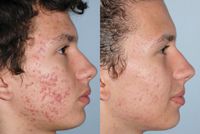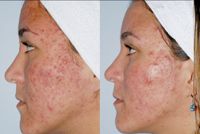- Acne
- Actinic Keratosis
- Aesthetics
- Alopecia
- Atopic Dermatitis
- Buy-and-Bill
- COVID-19
- Case-Based Roundtable
- Chronic Hand Eczema
- Chronic Spontaneous Urticaria
- Drug Watch
- Eczema
- General Dermatology
- Hidradenitis Suppurativa
- Melasma
- NP and PA
- Pediatric Dermatology
- Pigmentary Disorders
- Practice Management
- Precision Medicine and Biologics
- Prurigo Nodularis
- Psoriasis
- Psoriatic Arthritis
- Rare Disease
- Rosacea
- Skin Cancer
- Vitiligo
- Wound Care
Article
Photodynamic therapy: MAL-PDT improves inflammatory acne; limitations persist
Photodynamic therapy with methyl aminolevulinate cream and red light is associated with marked and relatively durable reductions in inflammatory lesion counts in patients with moderate inflammatory acne, an expert says.

Key Points


SAFETY, EFFICACY
Outcomes were assessed every four weeks based on evaluation of standardized photographs by the three treating dermatologists.
At the first follow-up, inflammatory lesion count was reduced by 37 percent from baseline. Additional treatments yielded further improvements. Mean inflammatory lesion count was reduced 49 percent at eight weeks and 71 percent at 12 weeks among the patients who received three treatments.
At six months, acne had worsened in three patients, but it had not reached pre-treatment severity.
ALTERNATIVE THERAPY
"Although very effective therapies for acne exist, there is a need for other alternatives, especially for the management of more severe disease, and that would address existing issues of Propionibacterium acnes antibiotic resistance, patient compliance, and the adverse events and complications associated with other treatments," Dr. Niwa tells Dermatology Times.
"Although our experience is open-label and uncontrolled, the treatment responses are consistent with previously reported outcomes in two randomized, controlled clinical trials," she says.
TREATMENT PROTOCOL
The treatment protocol involved application of MAL cream to the entire face under occlusion for 90 minutes. The total dose for the red light illumination was 37 J/cm2 .
"Cooling with forced air was provided during the light treatment and was helpful for improving discomfort. However, all patients rated their maximal pain as moderate to severe," Dr. Niwa says.
POST TREATMENT
Post treatment, all patients developed erythema and edema that persisted for three to five days and was followed by epithelial exfoliation.
One patient also developed a pustular eruption after the second treatment, which was recorded as aggravated acne.
Two patients with skin types III and IV developed postinflammatory hyperpigmentation one week after treatment, but it responded to a one-month course of topical corticosteroid treatment.
Disclosure: Dr. Niwa and her collaborators have no financial interest in the products mentioned.
Newsletter
Like what you’re reading? Subscribe to Dermatology Times for weekly updates on therapies, innovations, and real-world practice tips.











